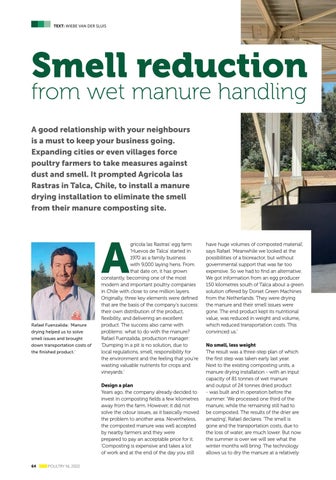TEXT: WIEBE VAN DER SLUIS
Smell reduction from wet manure handling A good relationship with your neighbours is a must to keep your business going. Expanding cities or even villages force poultry farmers to take measures against dust and smell. It prompted Agricola las Rastras in Talca, Chile, to install a manure drying installation to eliminate the smell from their manure composting site.
A
Rafael Fuenzalida: ‘Manure drying helped us to solve smell issues and brought down transportation costs of the finished product.’
gricola las Rastras’ egg farm ‘Huevos de Talca’ started in 1970 as a family business with 9,000 laying hens. From that date on, it has grown constantly, becoming one of the most modern and important poultry companies in Chile with close to one million layers. Originally, three key elements were defined that are the basis of the company’s success: their own distribution of the product, flexibility, and delivering an excellent product. The success also came with problems: what to do with the manure? Rafael Fuenzalida, production manager: ‘Dumping in a pit is no solution, due to local regulations, smell, responsibility for the environment and the feeling that you’re wasting valuable nutrients for crops and vineyards.’ Design a plan Years ago, the company already decided to invest in composting fields a few kilometres away from the farm. However, it did not solve the odour issues, as it basically moved the problem to another area. Nevertheless, the composted manure was well accepted by nearby farmers and they were prepared to pay an acceptable price for it. ‘Composting is expensive and takes a lot of work and at the end of the day you still
64
have huge volumes of composted material’, says Rafael. ‘Meanwhile we looked at the possibilities of a bioreactor, but without governmental support that was far too expensive. So we had to find an alternative. We got information from an egg producer 150 kilometres south of Talca about a green solution offered by Dorset Green Machines from the Netherlands. They were drying the manure and their smell issues were gone. The end product kept its nutritional value, was reduced in weight and volume, which reduced transportation costs. This convinced us.’ No smell, less weight The result was a three-step plan of which the first step was taken early last year. Next to the existing composting units, a manure drying installation - with an input capacity of 81 tonnes of wet manure and output of 24 tonnes dried product - was built and in operation before the summer. ‘We processed one third of the manure, while the remaining still had to be composted. The results of the drier are amazing’, Rafael declares. ‘The smell is gone and the transportation costs, due to the loss of water, are much lower. But now the summer is over we will see what the winter months will bring. The technology allows us to dry the manure at a relatively
POULTRY NL 2022
PoultryNL_2022_magazine.indd 64
08-05-2022 13:43









































